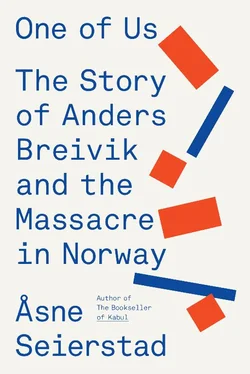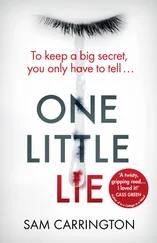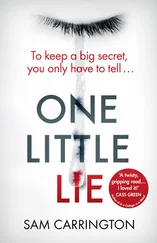The first time I mention someone, I have usually put down their full name. Some people do not appear in the book until ‘Friday’ – the chapter about 22 July – and disappear from the account the moment they are killed. These were the most painful parts of the book to send to their families. I asked all the parents affected to read the sections about their children and choose for themselves whether they wanted their child to be part of the book. For me, it was important to describe for posterity exactly how that day was. In the end, no parent objected that I wrote about their child’s moment of death. I am very grateful for that.
The surviving young people who contributed to the book were also sent their texts to read through and correct.
* * *
The other strand of this book is that man . A man many are reluctant to refer to by name. The perpetrator, the subject under observation, the accused, the defendant and finally: the sentenced prisoner. I do use his name. When writing about his childhood it was natural to use his first name; from 22 July onwards I use his surname or full name.
In journalism, it is important to go to the sources. This was the reason for my request for an interview with him. Its refusal obliged me to base my account on what others say about him. I talked to his friends, members of his family, classmates, colleagues and former political associates. I read what he himself had written: in the manifesto, on the internet and in letters. I also paid attention to what he had to say during the trial, and what he subsequently wrote in letters to the press and in official complaints.
Many of those close to him were unwilling to say anything. Some slammed down the phone. Others replied, ‘I’ve put him behind me. I’m through with him.’
I was not through with him, and eventually I found people who would talk, most of them anonymously. Very few of his former friends and classmates are named in this book. It is as though having known him leaves one branded. Even so, a number of people made important contributions to my understanding of what Anders Behring Breivik was like in childhood, adolescence and adult life. In the chapter about his time as a tagger, those described are given their actual tagging names and will thus be recognised within their own circles. In the chapter on the Progress Party, no one demanded anonymity. I have given two business partners and two childhood friends new names.
I tried for a year to secure an interview with Wenche Behring Breivik but her answer, through her lawyer Ragnhild Torgersen, was always the same: No.
In March 2013, I called her lawyer again. She said she would talk to her client one more time. Torgersen rang back: ‘Can you come to my office tomorrow?’
I was allowed to meet Wenche Behring Breivik on the condition that she and her lawyer be allowed to read through the interview afterwards. The agreement was that if Wenche Behring Breivik were incapable of reading through it herself – her cancer had entered its final phase – her lawyer would do it. This she did, and approved the use of the interview. Torgersen was also present during our conversation, and both of us recorded it. Parts of the interview appear in question-and-answer format; other parts are used to shed light on her son’s childhood in the chapters about his early life.
Several times I also requested a meeting with Jens David Breivik, the perpetrator’s father, but he would not be interviewed. I therefore had to restrict myself to what others told me about him. It was only when I sent him, in its entirety, what I had written about him that I was able to enter into a dialogue with him, in which he corrected items he felt were wrong and gave me new information about his son.
Reports from the Centre for Child and Adolescent Psychiatry were an invaluable source of information about Anders Behring Breivik’s childhood. I also talked to the professionals who observed him in that period. I judged this case to be so much in the public interest that it justified using information from confidential reports.
In addition, reports from the expert psychiatrists associated with the trial, Synne Sørheim and Torgeir Husby, Terje Tørrissen and Agnar Aspaas, were extremely helpful. The accounts of what took place in their meetings with Breivik are taken from their reports. Parts of these reports have appeared in the media in printed form; I worked from the uncensored versions.
I also made extensive use of the police interviews in the case. I had tens of thousands of pages of interviews, witness statements and background documents to read through and select from. In some instances I have used direct quotations from the interrogations. This applies to the interrogations of the perpetrator on Utøya and at police headquarters in Oslo, and to the interviews with his mother when she was brought in on 22 July, both in the police car and later that same evening at the police headquarters. The conversations between Anders and his mother in the months leading up to his move to the farm, and later on in the wake of 22 July, are reconstructed from what Wenche told investigators during the autumn of 2011. I have elected to make use of these documents that are not publicly available because I consider it justified by the vital importance of casting light on this terrorism case.
I have also used the police interviews of some witnesses who knew Breivik. In these instances, I have given no names.
The couple with whom Anders Behring Breivik was placed on several occasions when he was two years old did not wish to contribute to the book. The information I provide about them is taken exclusively from their police interviews.
Other than that, I largely used the police interviews as background information and to check the facts of Anders Behring Breivik’s life.
* * *
In a number of places in the book, I refer to the perpetrator’s thoughts or judgements. Readers might want to know: How does the author know this?
Everything is taken from what he himself said in police interviews, at the trial or to the psychiatrists.
I would like to give a few examples. In the chapter entitled ‘Friday’, I write in detail about Breivik’s thoughts during the first killings. In that sequence, various sentences are lifted directly from the trial transcripts. Breivik described his feelings and thoughts both to the police in the days after the terror act and in court nine months later, as follows: ‘I don’t feel remotely like doing this’ and ‘Now or never. It’s now or never.’ These sentences are used as direct quotations. In some places his statements are turned into indirect speech: ‘His body was fighting against it, his muscles were twitching. He felt he would never be able to go through with it. A hundred voices in his head were screaming: Don’t do it, don’t do it, don’t do it!’ It was Breivik who talked about his body and his muscles, and referred to the hundred voices screaming in his head. I have used his own words. That is how I have worked throughout the book. His thoughts set out here all derive from what he said in police or court documents.
My statement that it was easy for him to go on killing after the first assassinations is taken from what the gunman explicitly told the police and the court. He spoke at length about how difficult the first shot was and how easy it all felt once he broke through the barrier, an almost physical barrier. He said that initially it had felt unnatural to kill.
So the next question is this: Can we trust his account?
A journalist must constantly evaluate and bear in mind the degree of veracity in any statement. In Breivik’s case, a number of his stories seem rather far-fetched. This applies particularly to his accounts of his childhood and youth, the positive gloss he puts on them and on his own popularity, and his claim to have been a king in hip-hop circles and a rising star in the Progress Party. My doubts about his portrayal of these sections of his life stem from finding a large number of accounts that contradict the idealised picture he attempts to convey. These testimonies largely agree with each other and they diverge markedly from his own version of events.
Читать дальше












